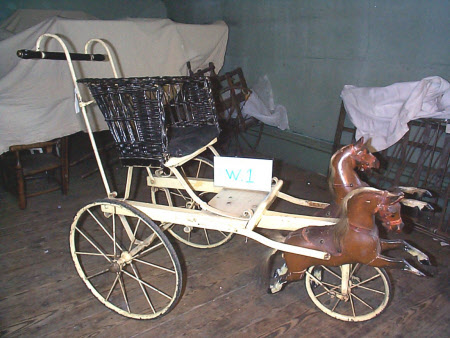Pushchair
probably G. & J. Lines Ltd
Category
Childcare objects
Date
circa 1880
Materials
Cane, wood, horsehair, leather and metal
Measurements
1280 mm (length); 490 mm (width); 895 mm (height)
Place of origin
London
Order this imageCollection
Sudbury Hall Museum of Childhood, Derbyshire
NT 670780.1
Summary
A child's or baby's pushchair known as a 'Galloper' or 'Baby's Pair-Horse Galloping Gig' (circa 1880). The pushchair was probably made by 'G & J Lines', England. The company were in production from circa 1880 to 1930 and also operating as 'J & G Lines'. 'G & J Lines' made several different early 20th century models including a 'Galloping Scooter' tricycle with pedals, a 'Walking Horse and Gig' tricycle with one horse and a 'Royal Gig' with 4 small radial spoked wheels and one horse fixed on a platform. It is possible that the horse have been repainted at one time as the horses on this type of model were often painted dappled grey and white. It has two large metal radial spoked wheels with rubber tyres at the rear and one small front centre wheel. Attached to the front wheel are two metal brackets which in turn are attached to two brown painted wooden horses which move with the wheel. Attached to the main frame by a metal bracket is a black painted wicker chair with a wooden seat. On the frame is a painted wooden foot plate. A painted metal handle is attached to the main frame and the basket, with a metal plate and bolt, and a black painted wooden handrail. The frame and wood are painted yellow. Each horse has a horse hair mane and tail, leather harness and saddle, black painted hooves and white fetlocks. A metal rod passes through each horse and attached to the pushchair by a central wooden and two outside metal shafts. The seat has a loose buttoned leather cushion. See inventory record - 663730. This 'Galloper' is very much like the one shown in the photograph (future King George VI as a little boy, sitting in a three-wheeled cart drawn by two wooden rocking-horses).
Makers and roles
probably G. & J. Lines Ltd , manufacturer Triang , manufacturer

